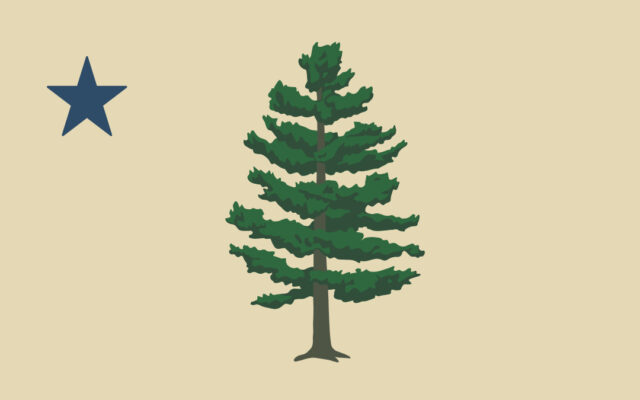
We may change Maine’s flag in November, but we won’t ditch its great seal
By Emily Burnham, Bangor Daily News Staff
When people talk about the upcoming statewide vote about whether or not to adopt the 1901 “lone pine” design for Maine’s state flag, the major argument in favor of the change is that our current flag — the Maine state seal on a blue background — is boring.
The design is nearly identical to the flags of 15 other states. It’s hard to tell Maine’s flag apart from the rest without squinting. The “new” design — actually the first state flag, in use from 1901 to 1909 — is more distinctive and recognizable, proponents say, with its simple but evocative pine tree and star.
It would distinguish us from the rest of the pack, including our neighbors New Hampshire and Vermont, which also have flags that are seals on a blue background. And we would not be the first state to change from that seal-on-blue design: Utah and Minnesota both changed their flags this year.
One thing that’s rarely mentioned in the flag change debate, however, is that the seal itself isn’t boring. It’s actually pretty cool.
The Great Seal of the State of Maine was first drawn up just as we became a state in 1820, and is attributed to two people: Bertha Smouse, a teenage resident of the town of Waldoboro, and her stepfather, Col. Isaac Reed, a Maine militiaman, lawyer and politician.
The story goes that the stepfather-daughter pair together came up with the basic idea for the seal in the early months of 1820, with Reed writing out the elements that would appear on the seal, and Smouse then creating a needlework sampler of the design. Among the limited educational opportunities for girls in the early 19th century was needlework, which was considered a “ladylike” endeavor that taught them the virtues of patience and concentration, and was also a useful skill for a future wife and mother. Smouse’s original needlework sampler is long gone, sadly.
When Smouse’s sampler was finished, Reed brought it to the newly formed Maine State Legislature. British-American politician and Hallowell resident Benjamin Vaughn made his own, more formal drawing of the seal, and on June 9, 1820, the Great Seal was adopted.
Reed’s description of the seal is filled with heraldic terminology that most people today don’t understand, but he explained in 1820 that the elements of the shield all had symbolic meaning. The pine tree, for example, he said was the “staple of the commerce of Maine, as the pride of her forests” and its “beauty is exceeded only by its usefulness.”
Reed said the north star represented Maine’s status as the northernmost state in the union at that time. It’s directly connected to the state’s motto, Dirigo, which means “I lead.” The north star, Reed wrote, “has been considered the mariner’s guide and director,” and is “used to denote the point to which all affections turn and as it here is intended to represent the state.”
The farmer and the sailor — referred to by Reed as a “husbandman” and a “seaman” — represent three of the state’s primary industries at the time: agriculture, fishing and shipping. In the 19th century, if you lived in Maine chances are you made your living off the land or the sea. That’s not as true today as it was 200 years ago.
The moose is referred to by Reed as a “moose deer.” A moose deer is not some hybrid of a moose and a deer that’s roaming the Maine woods like an antlered Bigfoot. Back in 1820, that’s what the people of European descent living in Maine called moose, which is the name Wabanaki people had called it for thousands of years. They eventually dropped the “deer” in favor of just “moose.”
Of the moose, Reed said that it represents the untouched wilderness of Maine, as the moose “retires before the approaching steps of human [habitation],” and represents nature in its undisturbed state, just as those who would settle those lands have a “spirit of independence [that] shall be untamed.” Pretty cool, right?
Maine did not adopt a state flag until 1901, more than 80 years after its founding. For the first 8 years, Maine used the “lone pine” flag, which is the one Mainers may vote for in November. According to Maine state archivist Kate McBrien, there is no known documentation as to why it was changed to the current flag in 1909. It just happened one day.
It should be made clear that, if the original flag is approved by voters on Nov. 5, the Great Seal of the State of Maine isn’t going anywhere. It’ll still be used on official state documents and signage. It’ll still represent our state as a symbol of its history, its values, its natural beauty and its place in the greater union. It’s been in use since the very beginning of Maine, and that’s not going to change.
The only thing that would change would be that the seal will no longer be plopped upon a blue background and flown from flagpoles. For that, we’d use something else — something that, proponents say, would underscore that Maine is different from other states. We’re unique, in the way we live our lives, in the things we believe and in the land beneath our feet.